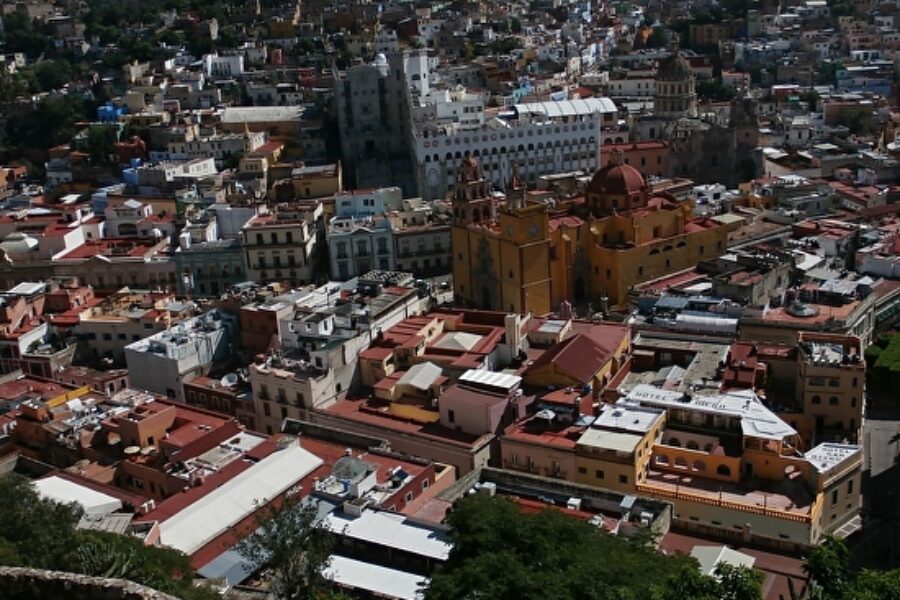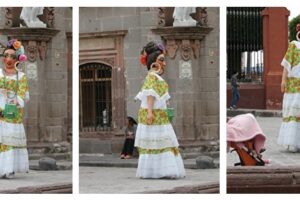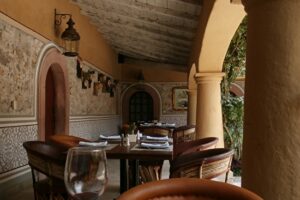Guanajuato From Above
We wind our way up the narrow streets to the high terrace where Pípila stands watch. I am so happy that we are not in our own car; that we are not driving—but being chauffeured by Benito. We crest the hill. Parking looks to be a problem until a young man in a hooded sweatshirt pulls a wooden crate from an empty slot. We slide in. I almost leave my shawl in the car until I remember the hooded sweatshirt; it must be cold up here, on top of the world. The shawl is wrapped tightly around me as we stand under the giant statue of Pípila and look at the expanse of Guanajuato; a city of brilliantly colored blocks stacked inside a deep green bowl.



Museo De Las Momias de Guanajuato
We have been here many times before, but never on a tour. We thought we would see if there were things we missed. Apparently, there are two.
Benito, our personal guide (our tour consists of only the two of us), talks about many things we know and some things that are totally new. One thing he tells us is, “The Mexicans say you have not been to Guanajuato till you go to the Museo De Las Momias de Guanajuato.”
I look at Michael. “I think we have to go.”
Before exiting the car, Benito tells us that he has seen it, and once is enough. He’ll wait while we tour. I begin to question my impulsive decision. It is good that a picture is worth a thousand words because there really are no words—no English words to read. No guide that speaks English to tell us why.
Walking through the Horror
Walking through the horror of this museum (the expressions on the faces are tortuous) reminded me of my own mortality. I remember a scene from the Dead Poet’s Society (one of my favorite movies of all time) when Robin Williams spoke to his students and said, “…Carpe…hear it? …Carpe, carpe diem, seize the day boys….”


Later, Benito explains that the city of Guanajuato is so lacking in space that, at one time, they rented the cemetery plots to families, with the rent due every so many years. If the rent was not paid, the bodies were exhumed, and if no one claimed them, well, here they are, making money for the city another way. The limestone in the burial ground preserved the bodies and mummified them. All I can think of is these poor souls did not intend to spend eternity this way—being stared at by the multitudes.
Carpe Diem! Yes!
Diego Rivera Museum
Back in the heart of the city, there is no place to park. Benito drops us off in front of the Diego Rivera Museum, leaving Michael and me to wander at will. The museum is more than an example of the diversity and talent of this famous Mexican artist; it is also a gallery to display the works of other artists. I have the luck of discovering the work of Pablo Santibañez Servat. I am amazed, feeling like I have been dropped on my head.
At first, I think I am looking at giant photographs, for it is a photographer’s eye I see before me. Zooming in, going for the detail—odd angles. But walking closer, I see they are paintings. Miraculous paintings. I get nose to nose with the canvas—studying brush strokes and colors. Amazed—amazed—amazed. To be able to bring carved wood, gilded in silver, to a one-dimensional canvas using only brown and gray and white with broad brush strokes—to create a blindingly brilliant sea, out of the palest gray and white—not a touch of blue—is genius. I could stare at these paintings forever.




Michael is more taken with the luminosity and softness of a rendering of an artist’s studio. I wonder why…
Our guide Benito appears and rushes us through the rest of the museum. I knew I didn’t like tours. But, if it weren’t for Benito, I would have missed this museum.
Lunch and More
On our way to lunch in the tiny pie-shaped Jardin, we pass the university—it is graduation day, and the streets are full of students and relatives—all celebrating with flowers.



We stop for a moment at the Basilica of Our Lady of Guanajuato, and the Mute Monk greets me—all bedecked in ribbons—this is our third meeting, and now I wonder about him. Our guide knows nothing, “There are too many saints. It is impossible to keep track.”
Eight years ago in Bernal, I looked for a simple wooden carving and fancied one that the shop owner called the Moot Monk. I bought it thinking it was one artist’s vision, but now I see him everywhere. It appears I have some Googling to do.
Lunch is lovely, it is another version of a chile relleno in an upscale restaurant that glistens and gleams throughout the interior, but we opt for the covered veranda. We have lingered too long, and it is time to return to San Miguel. We get a circuitous tour of the city on our way to the parking lot arriving in SMA an hour after the appointed time.








Tonight, back at our favorite Italian spot—two minutes from our casa—I find La Llorona a third time. The first mariachis were just no good—they couldn’t sing. The second on the Jardin was better, but the horns drowned out the lyrics. But tonight, while sipping wine at Antigua Trattoria Romana, a deep rich voice tells the tale so very well.
Pípila is everywhere in the state of Guanjuato…this is why…

Juan José de los Reyes Martínez Amaro, AKA el Pípila, was born in San Miguel, worked in the silver mines of Guanajuato, and was a hero of the Mexican revolution against Spain.
At the very beginning of the Mexican War of Independence, on 28 September 1810, the Spanish barricaded themselves–along with plenty of silver and other riches–in a grain warehouse known as the Alhóndiga de Granaditas. The granary was a stone fortress with high stone walls, but its wooden door proved to be an Achilles’ heel.
With a long, flat stone tied to his back to protect him from the muskets of the Spanish troops, Pípila carried tar and a torch to the door of the Alhóndiga and set it on fire. The insurgents–who far outnumbered the Spanish in the warehouse–stormed inside and killed all the soldiers and the civil Spanish refugees.

Michael and I can’t help but wonder if this is where Matthew Caldwell, his famous ancestor, was held prisoner in Guanajuato.
As captain of Company D of the scouting force on the Texan Santa Fe expedition in 1841, Matthew Caldwell was captured with the expedition and imprisoned in Mexico.
“President Lamar concluded that he wanted to open up some sort of communication and trade with Santa Fe, and he sent Capt. Paint Caldwell with about one hundred men to that far away city. This was very a very strange piece of diplomacy.
Caldwell was one of the most remarkable men that ever lived. He had a heart of gold, and the word fear conveyed no meaning to his soul. In open violation of every principle of international comity and courtesy, the whole force was made to surrender as prisoners of war in the city of Santa Fe. They were never treated as prisoners of war. Most of the men were loaded with chains and thrown into dungeons. After some time, they started on the long march to the City of Mexico on foot.
In a few days, the burning sun and the scorching sand began to crush the poor worn-out prisoners. One who understood the Spanish language heard an officer say to the guards, “If the Americano diablos drop in the road, cut their throats as you would a dog, and bring me their ears that I may account for my prisoners.” This act of butchery and inhumanity was performed several times. One day Capt. Caldwell himself fell on the road on the hot sand. A Mexican officer more humane than the others had become attached to the brave old veteran. He bent over the prostrate, and he thought, dying soldier, and whispered: “If you desire, I will cut your ears off and report you dead. Possibly you may hobble to some ranch and survive.”
The old captain could not bear the idea of losing his ears, struggling to his feet, rejoining his comrades. I think he was gone about eighteen months. The Mexican government released these prisoners but made them swear that they would never again bear arms against Mexico. Capt. Caldwell got home just in time to participate in the battle of Salado. He regarded the oath that he had taken under duress as nothing. He always said that he never intended to surrender again to any Mexican soldiers.”








Leave a Reply
Your email is safe with us.